Economics Coursework: Mining Industry, Issues, and Policy Report
VerifiedAdded on 2021/02/20
|10
|3006
|24
Report
AI Summary
This report delves into the Australian mining industry, examining its historical significance and contribution to the national economy through exports and employment. It explores the industry's market structure, highlighting the dominance of multinational corporations and the impact of mining booms on population growth and infrastructure. The report identifies key industry-associated issues, including the rebalance of demand and supply, access to capital, commodity price volatility, and the impact of technological advancements. It analyzes how these issues affect both the industry and the broader Australian economy, considering aspects such as employment rates, investment, and government revenue. Furthermore, the report discusses government policies implemented to regulate and support the mining sector, providing a comprehensive overview of the industry's economic dynamics and challenges.

ECONOMICS COURSE
WORK
WORK
Paraphrase This Document
Need a fresh take? Get an instant paraphrase of this document with our AI Paraphraser

Table of Contents
INTRODUCTION...........................................................................................................................1
INDUSTRY BACKGROUND .......................................................................................................1
MARKET STRUCTURE ...............................................................................................................2
INDUSTRY ASSOCIATED ISSUE ..............................................................................................2
IMPACT OF ISSUES ON THE INDUSTRY AND ON AUSTRALIA ECONOMY ...................4
GOVERNMENT POLICY..............................................................................................................6
CONCLUSION................................................................................................................................7
REFERENCES ...............................................................................................................................8
INTRODUCTION...........................................................................................................................1
INDUSTRY BACKGROUND .......................................................................................................1
MARKET STRUCTURE ...............................................................................................................2
INDUSTRY ASSOCIATED ISSUE ..............................................................................................2
IMPACT OF ISSUES ON THE INDUSTRY AND ON AUSTRALIA ECONOMY ...................4
GOVERNMENT POLICY..............................................................................................................6
CONCLUSION................................................................................................................................7
REFERENCES ...............................................................................................................................8
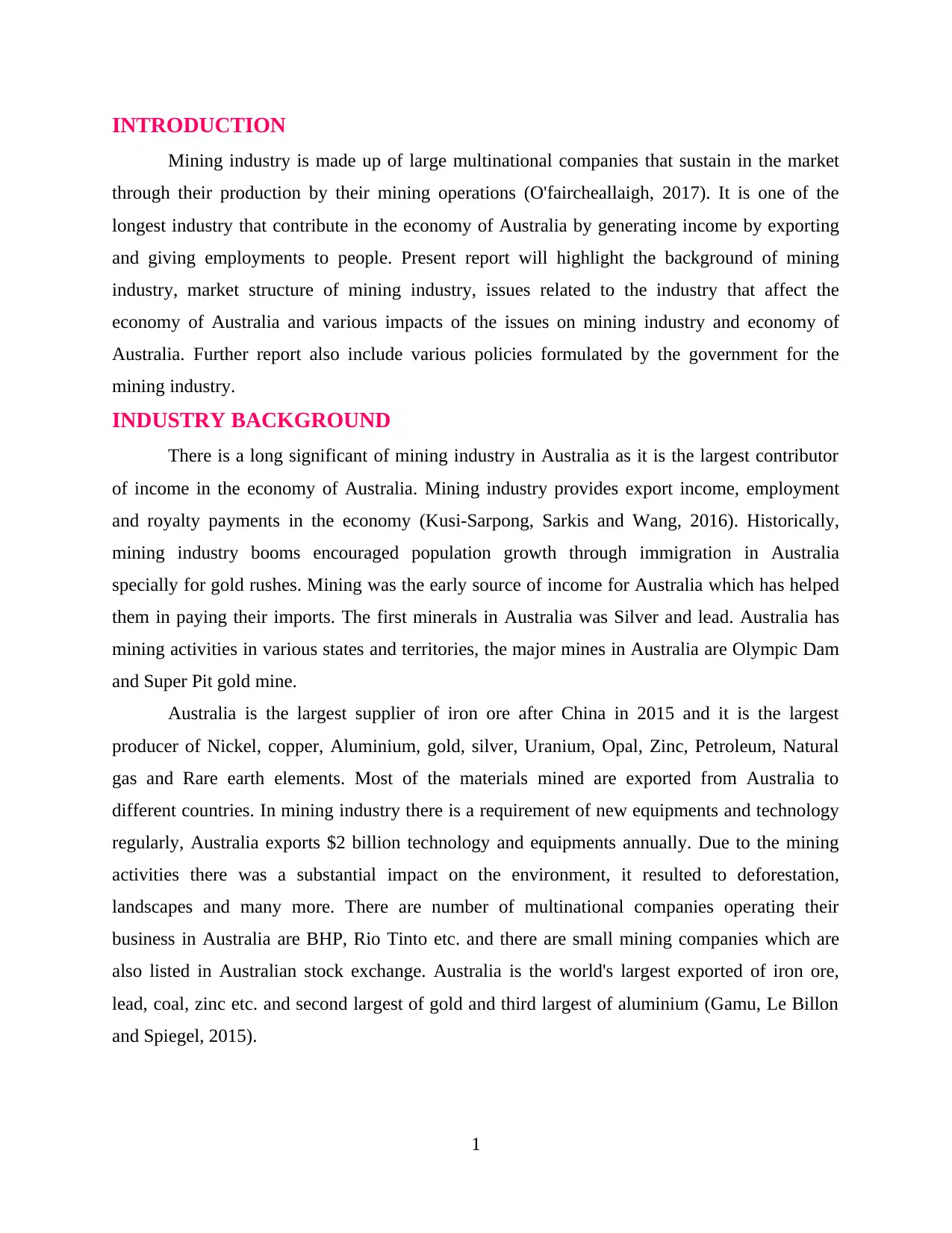
INTRODUCTION
Mining industry is made up of large multinational companies that sustain in the market
through their production by their mining operations (O'faircheallaigh, 2017). It is one of the
longest industry that contribute in the economy of Australia by generating income by exporting
and giving employments to people. Present report will highlight the background of mining
industry, market structure of mining industry, issues related to the industry that affect the
economy of Australia and various impacts of the issues on mining industry and economy of
Australia. Further report also include various policies formulated by the government for the
mining industry.
INDUSTRY BACKGROUND
There is a long significant of mining industry in Australia as it is the largest contributor
of income in the economy of Australia. Mining industry provides export income, employment
and royalty payments in the economy (Kusi-Sarpong, Sarkis and Wang, 2016). Historically,
mining industry booms encouraged population growth through immigration in Australia
specially for gold rushes. Mining was the early source of income for Australia which has helped
them in paying their imports. The first minerals in Australia was Silver and lead. Australia has
mining activities in various states and territories, the major mines in Australia are Olympic Dam
and Super Pit gold mine.
Australia is the largest supplier of iron ore after China in 2015 and it is the largest
producer of Nickel, copper, Aluminium, gold, silver, Uranium, Opal, Zinc, Petroleum, Natural
gas and Rare earth elements. Most of the materials mined are exported from Australia to
different countries. In mining industry there is a requirement of new equipments and technology
regularly, Australia exports $2 billion technology and equipments annually. Due to the mining
activities there was a substantial impact on the environment, it resulted to deforestation,
landscapes and many more. There are number of multinational companies operating their
business in Australia are BHP, Rio Tinto etc. and there are small mining companies which are
also listed in Australian stock exchange. Australia is the world's largest exported of iron ore,
lead, coal, zinc etc. and second largest of gold and third largest of aluminium (Gamu, Le Billon
and Spiegel, 2015).
1
Mining industry is made up of large multinational companies that sustain in the market
through their production by their mining operations (O'faircheallaigh, 2017). It is one of the
longest industry that contribute in the economy of Australia by generating income by exporting
and giving employments to people. Present report will highlight the background of mining
industry, market structure of mining industry, issues related to the industry that affect the
economy of Australia and various impacts of the issues on mining industry and economy of
Australia. Further report also include various policies formulated by the government for the
mining industry.
INDUSTRY BACKGROUND
There is a long significant of mining industry in Australia as it is the largest contributor
of income in the economy of Australia. Mining industry provides export income, employment
and royalty payments in the economy (Kusi-Sarpong, Sarkis and Wang, 2016). Historically,
mining industry booms encouraged population growth through immigration in Australia
specially for gold rushes. Mining was the early source of income for Australia which has helped
them in paying their imports. The first minerals in Australia was Silver and lead. Australia has
mining activities in various states and territories, the major mines in Australia are Olympic Dam
and Super Pit gold mine.
Australia is the largest supplier of iron ore after China in 2015 and it is the largest
producer of Nickel, copper, Aluminium, gold, silver, Uranium, Opal, Zinc, Petroleum, Natural
gas and Rare earth elements. Most of the materials mined are exported from Australia to
different countries. In mining industry there is a requirement of new equipments and technology
regularly, Australia exports $2 billion technology and equipments annually. Due to the mining
activities there was a substantial impact on the environment, it resulted to deforestation,
landscapes and many more. There are number of multinational companies operating their
business in Australia are BHP, Rio Tinto etc. and there are small mining companies which are
also listed in Australian stock exchange. Australia is the world's largest exported of iron ore,
lead, coal, zinc etc. and second largest of gold and third largest of aluminium (Gamu, Le Billon
and Spiegel, 2015).
1
⊘ This is a preview!⊘
Do you want full access?
Subscribe today to unlock all pages.

Trusted by 1+ million students worldwide
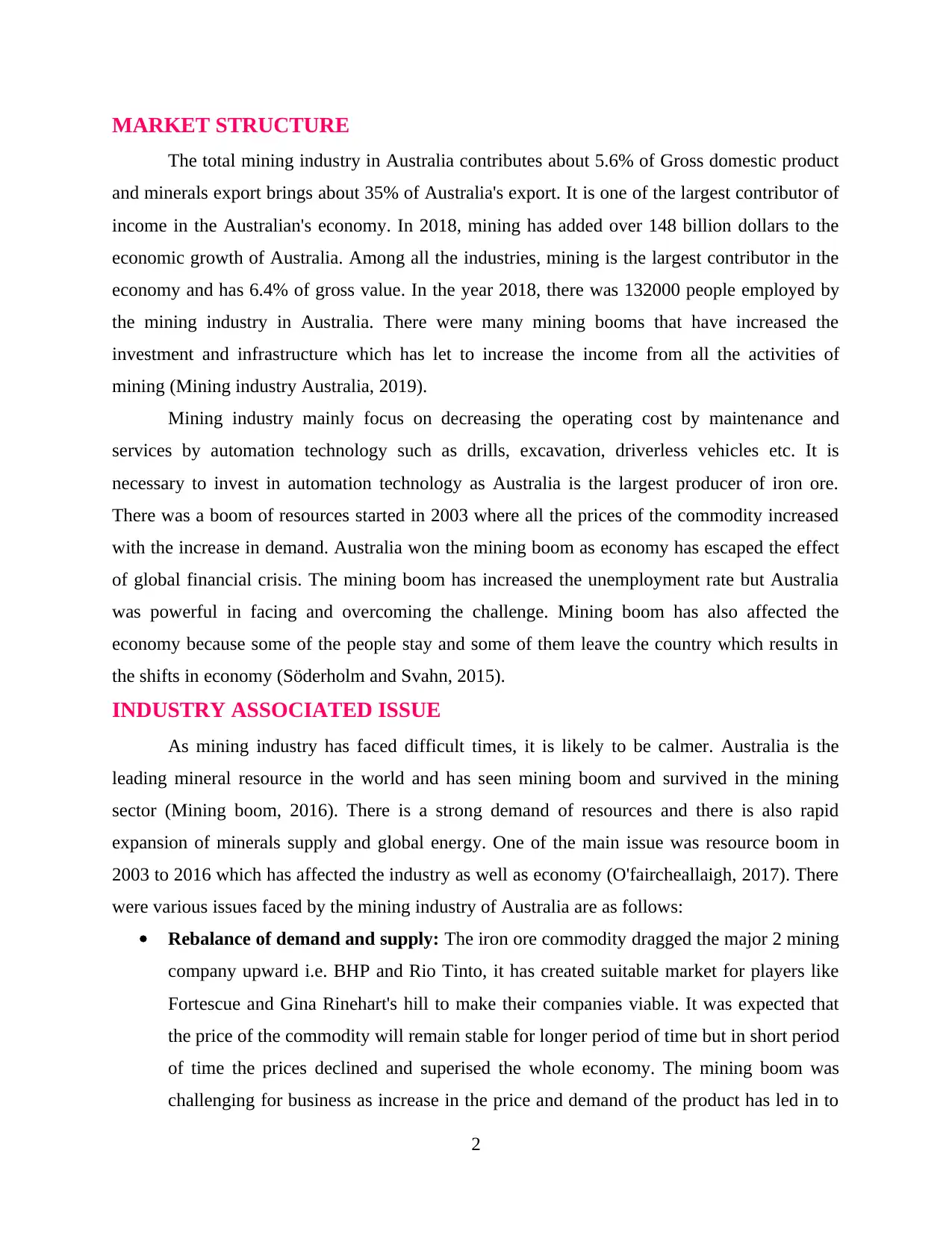
MARKET STRUCTURE
The total mining industry in Australia contributes about 5.6% of Gross domestic product
and minerals export brings about 35% of Australia's export. It is one of the largest contributor of
income in the Australian's economy. In 2018, mining has added over 148 billion dollars to the
economic growth of Australia. Among all the industries, mining is the largest contributor in the
economy and has 6.4% of gross value. In the year 2018, there was 132000 people employed by
the mining industry in Australia. There were many mining booms that have increased the
investment and infrastructure which has let to increase the income from all the activities of
mining (Mining industry Australia, 2019).
Mining industry mainly focus on decreasing the operating cost by maintenance and
services by automation technology such as drills, excavation, driverless vehicles etc. It is
necessary to invest in automation technology as Australia is the largest producer of iron ore.
There was a boom of resources started in 2003 where all the prices of the commodity increased
with the increase in demand. Australia won the mining boom as economy has escaped the effect
of global financial crisis. The mining boom has increased the unemployment rate but Australia
was powerful in facing and overcoming the challenge. Mining boom has also affected the
economy because some of the people stay and some of them leave the country which results in
the shifts in economy (Söderholm and Svahn, 2015).
INDUSTRY ASSOCIATED ISSUE
As mining industry has faced difficult times, it is likely to be calmer. Australia is the
leading mineral resource in the world and has seen mining boom and survived in the mining
sector (Mining boom, 2016). There is a strong demand of resources and there is also rapid
expansion of minerals supply and global energy. One of the main issue was resource boom in
2003 to 2016 which has affected the industry as well as economy (O'faircheallaigh, 2017). There
were various issues faced by the mining industry of Australia are as follows:
Rebalance of demand and supply: The iron ore commodity dragged the major 2 mining
company upward i.e. BHP and Rio Tinto, it has created suitable market for players like
Fortescue and Gina Rinehart's hill to make their companies viable. It was expected that
the price of the commodity will remain stable for longer period of time but in short period
of time the prices declined and superised the whole economy. The mining boom was
challenging for business as increase in the price and demand of the product has led in to
2
The total mining industry in Australia contributes about 5.6% of Gross domestic product
and minerals export brings about 35% of Australia's export. It is one of the largest contributor of
income in the Australian's economy. In 2018, mining has added over 148 billion dollars to the
economic growth of Australia. Among all the industries, mining is the largest contributor in the
economy and has 6.4% of gross value. In the year 2018, there was 132000 people employed by
the mining industry in Australia. There were many mining booms that have increased the
investment and infrastructure which has let to increase the income from all the activities of
mining (Mining industry Australia, 2019).
Mining industry mainly focus on decreasing the operating cost by maintenance and
services by automation technology such as drills, excavation, driverless vehicles etc. It is
necessary to invest in automation technology as Australia is the largest producer of iron ore.
There was a boom of resources started in 2003 where all the prices of the commodity increased
with the increase in demand. Australia won the mining boom as economy has escaped the effect
of global financial crisis. The mining boom has increased the unemployment rate but Australia
was powerful in facing and overcoming the challenge. Mining boom has also affected the
economy because some of the people stay and some of them leave the country which results in
the shifts in economy (Söderholm and Svahn, 2015).
INDUSTRY ASSOCIATED ISSUE
As mining industry has faced difficult times, it is likely to be calmer. Australia is the
leading mineral resource in the world and has seen mining boom and survived in the mining
sector (Mining boom, 2016). There is a strong demand of resources and there is also rapid
expansion of minerals supply and global energy. One of the main issue was resource boom in
2003 to 2016 which has affected the industry as well as economy (O'faircheallaigh, 2017). There
were various issues faced by the mining industry of Australia are as follows:
Rebalance of demand and supply: The iron ore commodity dragged the major 2 mining
company upward i.e. BHP and Rio Tinto, it has created suitable market for players like
Fortescue and Gina Rinehart's hill to make their companies viable. It was expected that
the price of the commodity will remain stable for longer period of time but in short period
of time the prices declined and superised the whole economy. The mining boom was
challenging for business as increase in the price and demand of the product has led in to
2
Paraphrase This Document
Need a fresh take? Get an instant paraphrase of this document with our AI Paraphraser
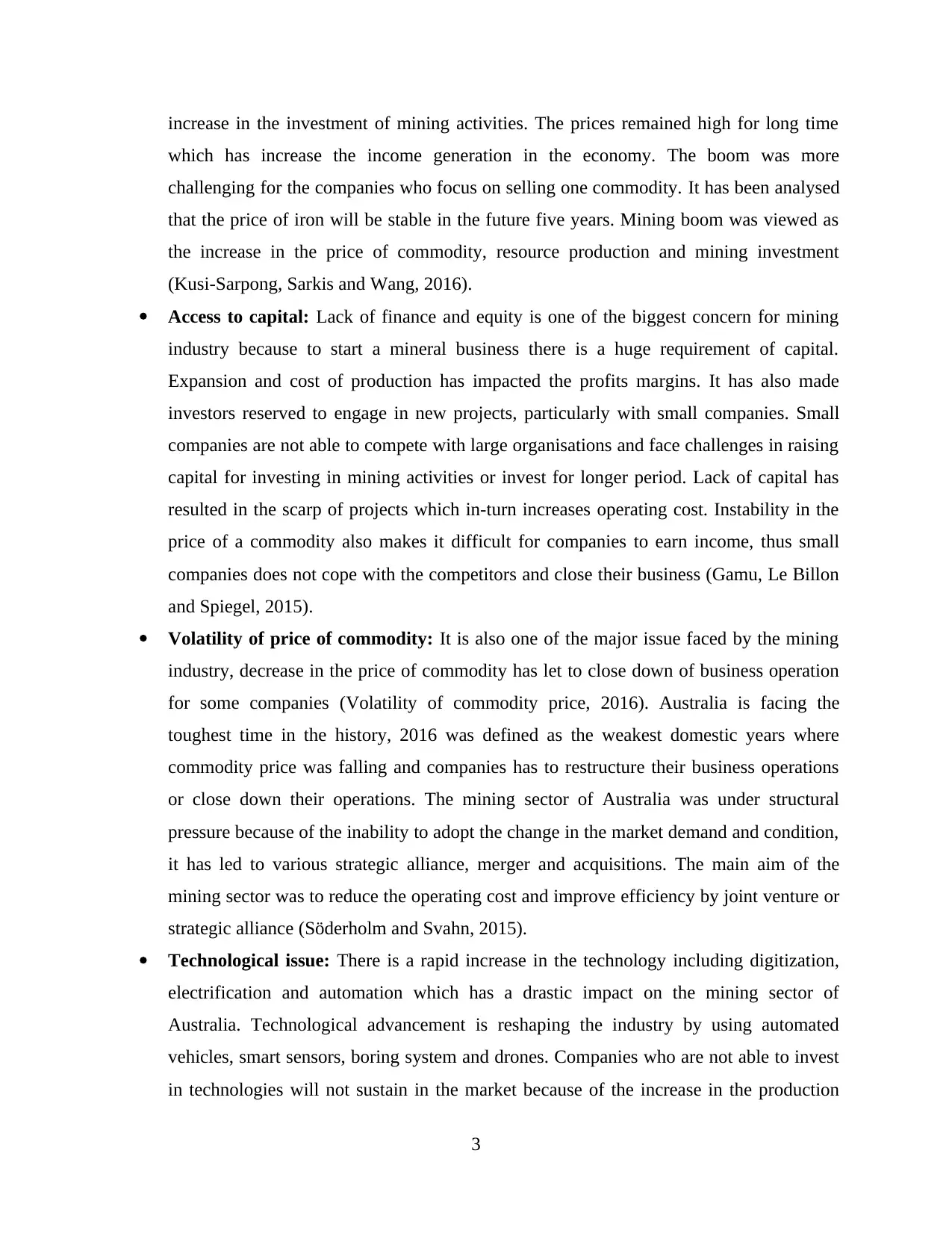
increase in the investment of mining activities. The prices remained high for long time
which has increase the income generation in the economy. The boom was more
challenging for the companies who focus on selling one commodity. It has been analysed
that the price of iron will be stable in the future five years. Mining boom was viewed as
the increase in the price of commodity, resource production and mining investment
(Kusi-Sarpong, Sarkis and Wang, 2016).
Access to capital: Lack of finance and equity is one of the biggest concern for mining
industry because to start a mineral business there is a huge requirement of capital.
Expansion and cost of production has impacted the profits margins. It has also made
investors reserved to engage in new projects, particularly with small companies. Small
companies are not able to compete with large organisations and face challenges in raising
capital for investing in mining activities or invest for longer period. Lack of capital has
resulted in the scarp of projects which in-turn increases operating cost. Instability in the
price of a commodity also makes it difficult for companies to earn income, thus small
companies does not cope with the competitors and close their business (Gamu, Le Billon
and Spiegel, 2015).
Volatility of price of commodity: It is also one of the major issue faced by the mining
industry, decrease in the price of commodity has let to close down of business operation
for some companies (Volatility of commodity price, 2016). Australia is facing the
toughest time in the history, 2016 was defined as the weakest domestic years where
commodity price was falling and companies has to restructure their business operations
or close down their operations. The mining sector of Australia was under structural
pressure because of the inability to adopt the change in the market demand and condition,
it has led to various strategic alliance, merger and acquisitions. The main aim of the
mining sector was to reduce the operating cost and improve efficiency by joint venture or
strategic alliance (Söderholm and Svahn, 2015).
Technological issue: There is a rapid increase in the technology including digitization,
electrification and automation which has a drastic impact on the mining sector of
Australia. Technological advancement is reshaping the industry by using automated
vehicles, smart sensors, boring system and drones. Companies who are not able to invest
in technologies will not sustain in the market because of the increase in the production
3
which has increase the income generation in the economy. The boom was more
challenging for the companies who focus on selling one commodity. It has been analysed
that the price of iron will be stable in the future five years. Mining boom was viewed as
the increase in the price of commodity, resource production and mining investment
(Kusi-Sarpong, Sarkis and Wang, 2016).
Access to capital: Lack of finance and equity is one of the biggest concern for mining
industry because to start a mineral business there is a huge requirement of capital.
Expansion and cost of production has impacted the profits margins. It has also made
investors reserved to engage in new projects, particularly with small companies. Small
companies are not able to compete with large organisations and face challenges in raising
capital for investing in mining activities or invest for longer period. Lack of capital has
resulted in the scarp of projects which in-turn increases operating cost. Instability in the
price of a commodity also makes it difficult for companies to earn income, thus small
companies does not cope with the competitors and close their business (Gamu, Le Billon
and Spiegel, 2015).
Volatility of price of commodity: It is also one of the major issue faced by the mining
industry, decrease in the price of commodity has let to close down of business operation
for some companies (Volatility of commodity price, 2016). Australia is facing the
toughest time in the history, 2016 was defined as the weakest domestic years where
commodity price was falling and companies has to restructure their business operations
or close down their operations. The mining sector of Australia was under structural
pressure because of the inability to adopt the change in the market demand and condition,
it has led to various strategic alliance, merger and acquisitions. The main aim of the
mining sector was to reduce the operating cost and improve efficiency by joint venture or
strategic alliance (Söderholm and Svahn, 2015).
Technological issue: There is a rapid increase in the technology including digitization,
electrification and automation which has a drastic impact on the mining sector of
Australia. Technological advancement is reshaping the industry by using automated
vehicles, smart sensors, boring system and drones. Companies who are not able to invest
in technologies will not sustain in the market because of the increase in the production
3
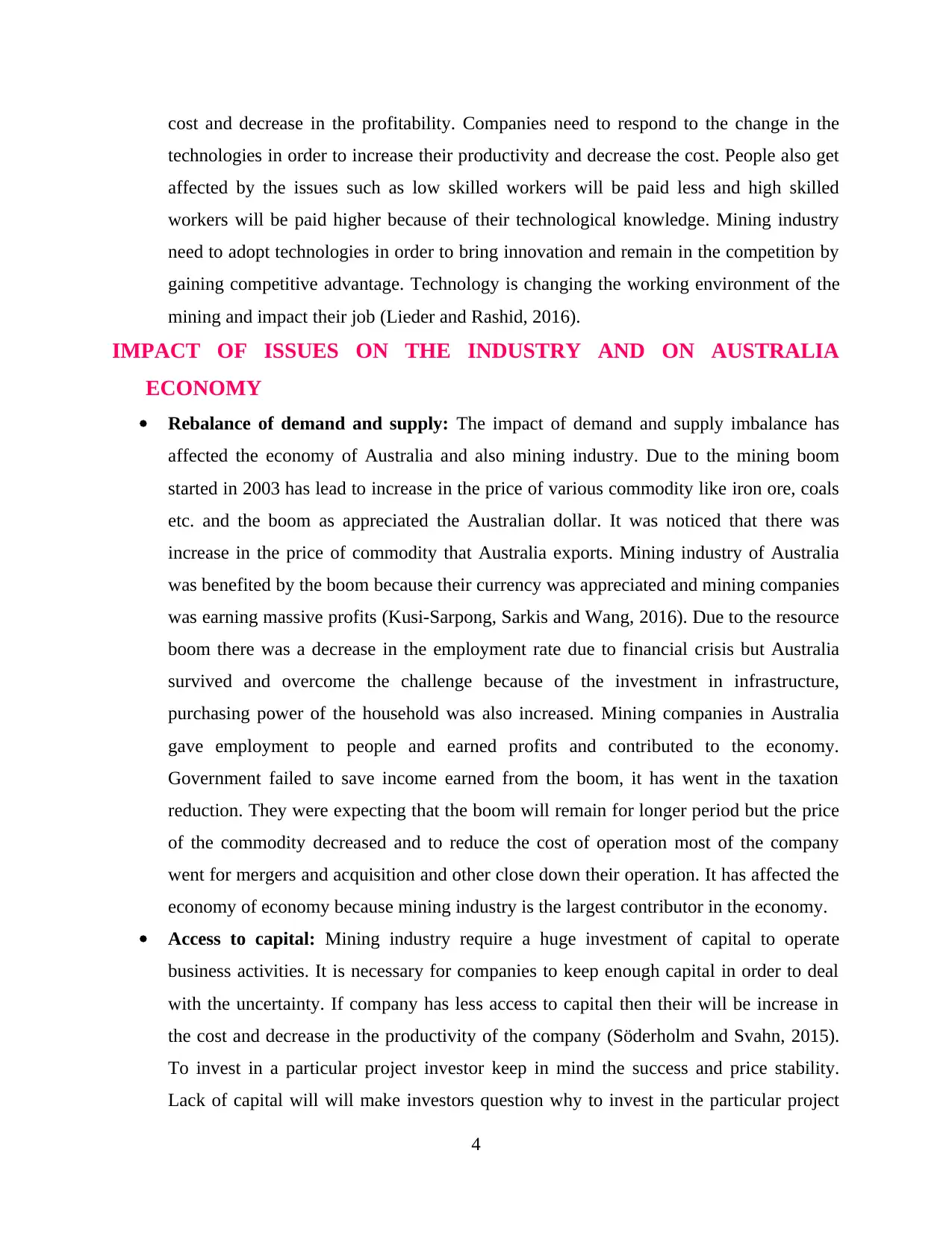
cost and decrease in the profitability. Companies need to respond to the change in the
technologies in order to increase their productivity and decrease the cost. People also get
affected by the issues such as low skilled workers will be paid less and high skilled
workers will be paid higher because of their technological knowledge. Mining industry
need to adopt technologies in order to bring innovation and remain in the competition by
gaining competitive advantage. Technology is changing the working environment of the
mining and impact their job (Lieder and Rashid, 2016).
IMPACT OF ISSUES ON THE INDUSTRY AND ON AUSTRALIA
ECONOMY
Rebalance of demand and supply: The impact of demand and supply imbalance has
affected the economy of Australia and also mining industry. Due to the mining boom
started in 2003 has lead to increase in the price of various commodity like iron ore, coals
etc. and the boom as appreciated the Australian dollar. It was noticed that there was
increase in the price of commodity that Australia exports. Mining industry of Australia
was benefited by the boom because their currency was appreciated and mining companies
was earning massive profits (Kusi-Sarpong, Sarkis and Wang, 2016). Due to the resource
boom there was a decrease in the employment rate due to financial crisis but Australia
survived and overcome the challenge because of the investment in infrastructure,
purchasing power of the household was also increased. Mining companies in Australia
gave employment to people and earned profits and contributed to the economy.
Government failed to save income earned from the boom, it has went in the taxation
reduction. They were expecting that the boom will remain for longer period but the price
of the commodity decreased and to reduce the cost of operation most of the company
went for mergers and acquisition and other close down their operation. It has affected the
economy of economy because mining industry is the largest contributor in the economy.
Access to capital: Mining industry require a huge investment of capital to operate
business activities. It is necessary for companies to keep enough capital in order to deal
with the uncertainty. If company has less access to capital then their will be increase in
the cost and decrease in the productivity of the company (Söderholm and Svahn, 2015).
To invest in a particular project investor keep in mind the success and price stability.
Lack of capital will will make investors question why to invest in the particular project
4
technologies in order to increase their productivity and decrease the cost. People also get
affected by the issues such as low skilled workers will be paid less and high skilled
workers will be paid higher because of their technological knowledge. Mining industry
need to adopt technologies in order to bring innovation and remain in the competition by
gaining competitive advantage. Technology is changing the working environment of the
mining and impact their job (Lieder and Rashid, 2016).
IMPACT OF ISSUES ON THE INDUSTRY AND ON AUSTRALIA
ECONOMY
Rebalance of demand and supply: The impact of demand and supply imbalance has
affected the economy of Australia and also mining industry. Due to the mining boom
started in 2003 has lead to increase in the price of various commodity like iron ore, coals
etc. and the boom as appreciated the Australian dollar. It was noticed that there was
increase in the price of commodity that Australia exports. Mining industry of Australia
was benefited by the boom because their currency was appreciated and mining companies
was earning massive profits (Kusi-Sarpong, Sarkis and Wang, 2016). Due to the resource
boom there was a decrease in the employment rate due to financial crisis but Australia
survived and overcome the challenge because of the investment in infrastructure,
purchasing power of the household was also increased. Mining companies in Australia
gave employment to people and earned profits and contributed to the economy.
Government failed to save income earned from the boom, it has went in the taxation
reduction. They were expecting that the boom will remain for longer period but the price
of the commodity decreased and to reduce the cost of operation most of the company
went for mergers and acquisition and other close down their operation. It has affected the
economy of economy because mining industry is the largest contributor in the economy.
Access to capital: Mining industry require a huge investment of capital to operate
business activities. It is necessary for companies to keep enough capital in order to deal
with the uncertainty. If company has less access to capital then their will be increase in
the cost and decrease in the productivity of the company (Söderholm and Svahn, 2015).
To invest in a particular project investor keep in mind the success and price stability.
Lack of capital will will make investors question why to invest in the particular project
4
⊘ This is a preview!⊘
Do you want full access?
Subscribe today to unlock all pages.

Trusted by 1+ million students worldwide
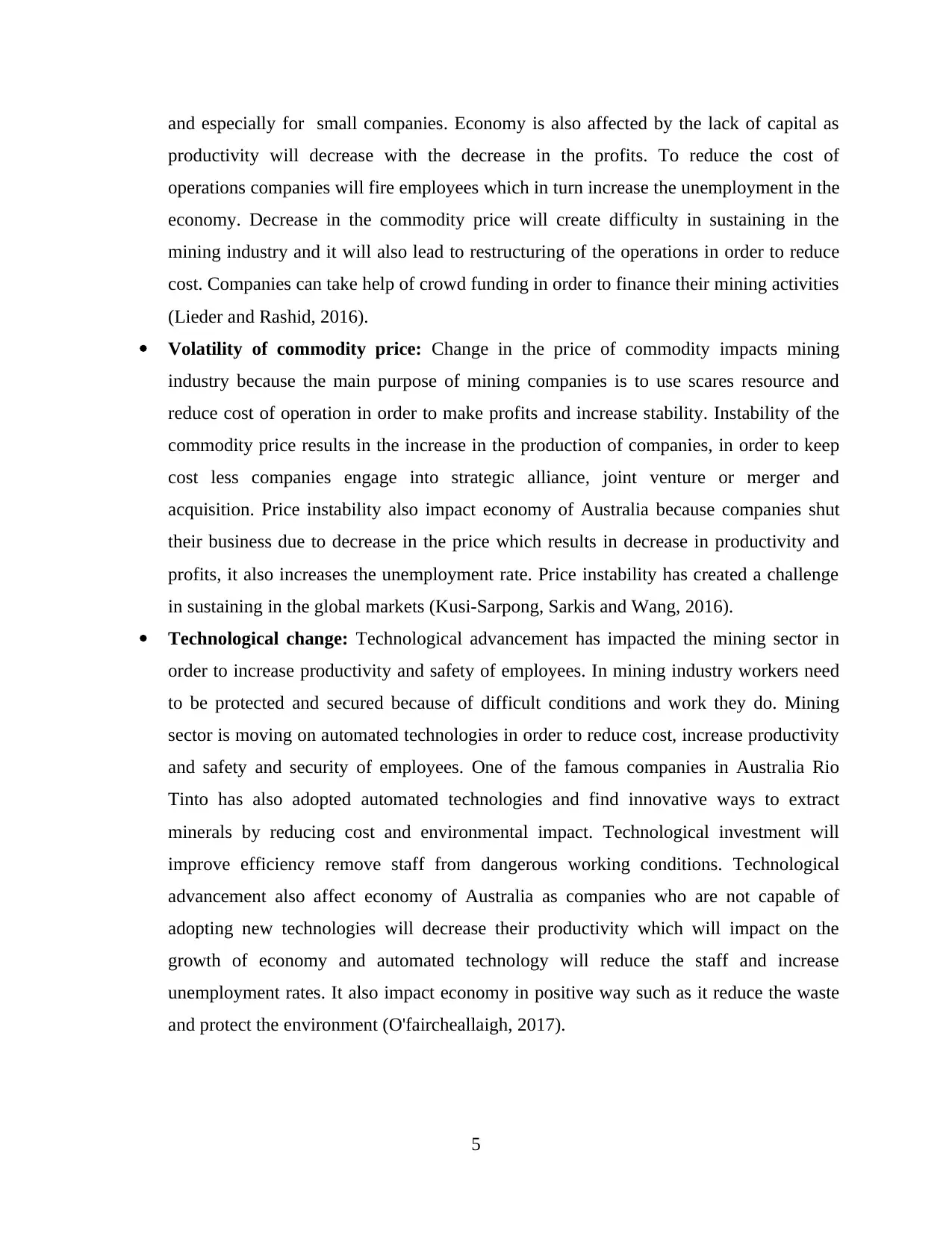
and especially for small companies. Economy is also affected by the lack of capital as
productivity will decrease with the decrease in the profits. To reduce the cost of
operations companies will fire employees which in turn increase the unemployment in the
economy. Decrease in the commodity price will create difficulty in sustaining in the
mining industry and it will also lead to restructuring of the operations in order to reduce
cost. Companies can take help of crowd funding in order to finance their mining activities
(Lieder and Rashid, 2016).
Volatility of commodity price: Change in the price of commodity impacts mining
industry because the main purpose of mining companies is to use scares resource and
reduce cost of operation in order to make profits and increase stability. Instability of the
commodity price results in the increase in the production of companies, in order to keep
cost less companies engage into strategic alliance, joint venture or merger and
acquisition. Price instability also impact economy of Australia because companies shut
their business due to decrease in the price which results in decrease in productivity and
profits, it also increases the unemployment rate. Price instability has created a challenge
in sustaining in the global markets (Kusi-Sarpong, Sarkis and Wang, 2016).
Technological change: Technological advancement has impacted the mining sector in
order to increase productivity and safety of employees. In mining industry workers need
to be protected and secured because of difficult conditions and work they do. Mining
sector is moving on automated technologies in order to reduce cost, increase productivity
and safety and security of employees. One of the famous companies in Australia Rio
Tinto has also adopted automated technologies and find innovative ways to extract
minerals by reducing cost and environmental impact. Technological investment will
improve efficiency remove staff from dangerous working conditions. Technological
advancement also affect economy of Australia as companies who are not capable of
adopting new technologies will decrease their productivity which will impact on the
growth of economy and automated technology will reduce the staff and increase
unemployment rates. It also impact economy in positive way such as it reduce the waste
and protect the environment (O'faircheallaigh, 2017).
5
productivity will decrease with the decrease in the profits. To reduce the cost of
operations companies will fire employees which in turn increase the unemployment in the
economy. Decrease in the commodity price will create difficulty in sustaining in the
mining industry and it will also lead to restructuring of the operations in order to reduce
cost. Companies can take help of crowd funding in order to finance their mining activities
(Lieder and Rashid, 2016).
Volatility of commodity price: Change in the price of commodity impacts mining
industry because the main purpose of mining companies is to use scares resource and
reduce cost of operation in order to make profits and increase stability. Instability of the
commodity price results in the increase in the production of companies, in order to keep
cost less companies engage into strategic alliance, joint venture or merger and
acquisition. Price instability also impact economy of Australia because companies shut
their business due to decrease in the price which results in decrease in productivity and
profits, it also increases the unemployment rate. Price instability has created a challenge
in sustaining in the global markets (Kusi-Sarpong, Sarkis and Wang, 2016).
Technological change: Technological advancement has impacted the mining sector in
order to increase productivity and safety of employees. In mining industry workers need
to be protected and secured because of difficult conditions and work they do. Mining
sector is moving on automated technologies in order to reduce cost, increase productivity
and safety and security of employees. One of the famous companies in Australia Rio
Tinto has also adopted automated technologies and find innovative ways to extract
minerals by reducing cost and environmental impact. Technological investment will
improve efficiency remove staff from dangerous working conditions. Technological
advancement also affect economy of Australia as companies who are not capable of
adopting new technologies will decrease their productivity which will impact on the
growth of economy and automated technology will reduce the staff and increase
unemployment rates. It also impact economy in positive way such as it reduce the waste
and protect the environment (O'faircheallaigh, 2017).
5
Paraphrase This Document
Need a fresh take? Get an instant paraphrase of this document with our AI Paraphraser
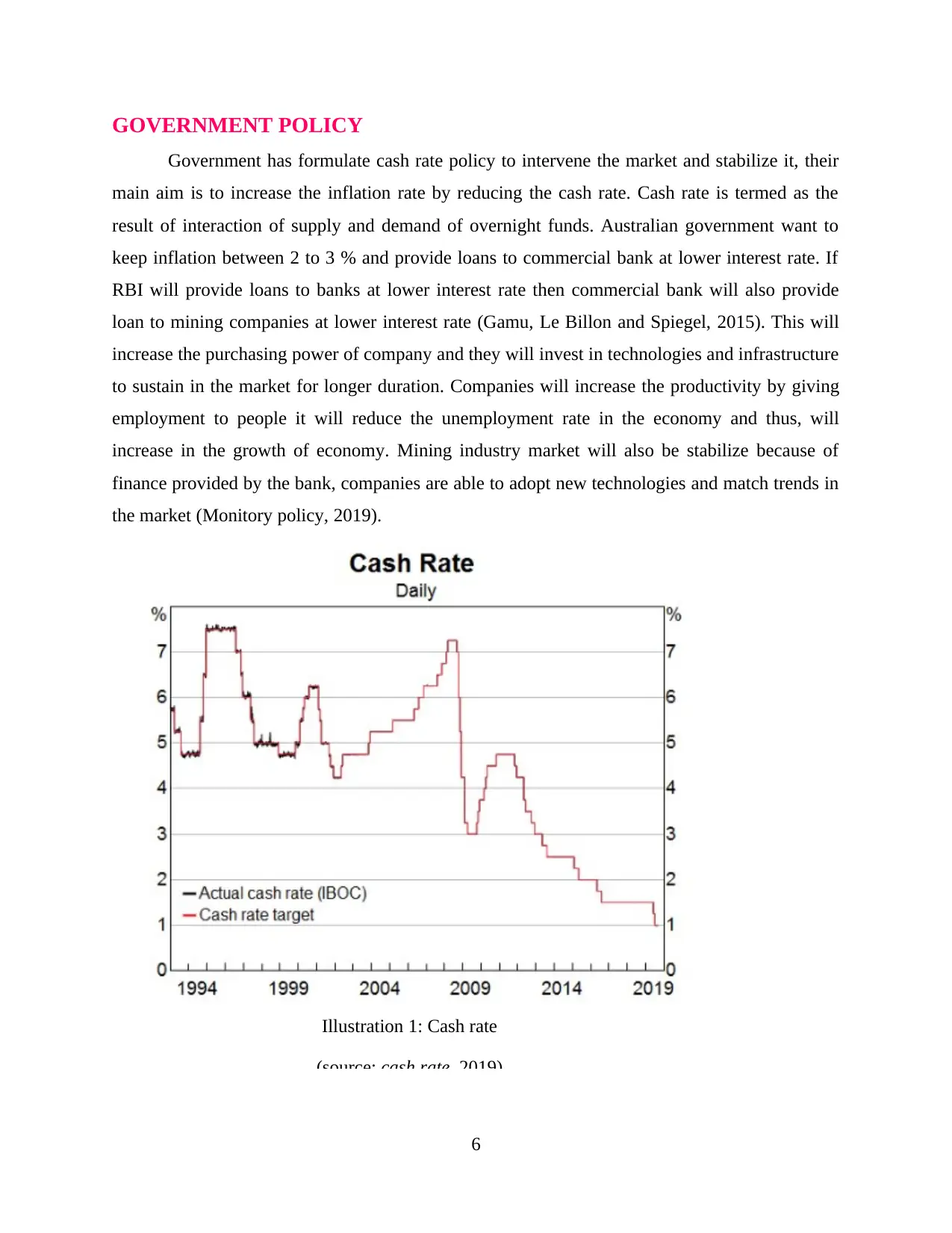
GOVERNMENT POLICY
Government has formulate cash rate policy to intervene the market and stabilize it, their
main aim is to increase the inflation rate by reducing the cash rate. Cash rate is termed as the
result of interaction of supply and demand of overnight funds. Australian government want to
keep inflation between 2 to 3 % and provide loans to commercial bank at lower interest rate. If
RBI will provide loans to banks at lower interest rate then commercial bank will also provide
loan to mining companies at lower interest rate (Gamu, Le Billon and Spiegel, 2015). This will
increase the purchasing power of company and they will invest in technologies and infrastructure
to sustain in the market for longer duration. Companies will increase the productivity by giving
employment to people it will reduce the unemployment rate in the economy and thus, will
increase in the growth of economy. Mining industry market will also be stabilize because of
finance provided by the bank, companies are able to adopt new technologies and match trends in
the market (Monitory policy, 2019).
Illustration 1: Cash rate
(source: cash rate, 2019)
6
Government has formulate cash rate policy to intervene the market and stabilize it, their
main aim is to increase the inflation rate by reducing the cash rate. Cash rate is termed as the
result of interaction of supply and demand of overnight funds. Australian government want to
keep inflation between 2 to 3 % and provide loans to commercial bank at lower interest rate. If
RBI will provide loans to banks at lower interest rate then commercial bank will also provide
loan to mining companies at lower interest rate (Gamu, Le Billon and Spiegel, 2015). This will
increase the purchasing power of company and they will invest in technologies and infrastructure
to sustain in the market for longer duration. Companies will increase the productivity by giving
employment to people it will reduce the unemployment rate in the economy and thus, will
increase in the growth of economy. Mining industry market will also be stabilize because of
finance provided by the bank, companies are able to adopt new technologies and match trends in
the market (Monitory policy, 2019).
Illustration 1: Cash rate
(source: cash rate, 2019)
6

To maintain the money supply in the economy government purchase and sell the bonds
so that there is a flow of money. The main aim of the monitory policy is to maintain price
stability in the economy because if the price of commodity decreases then mining companies
have to do restructuring of their business operations to reduce cost or they focus on mergers and
acquisitions. Government maintain the inflation rate to 2 to 3 % in order to maintain the flow of
money so that companies grow their business and maintain stability in the market. Maintaining
the price stability will increase the efficiency of work, productivity and contribute in reducing
unemployment rate (Kusi-Sarpong, Sarkis and Wang, 2016).
CONCLUSION
From the above report it is concluded that mining industry plays an important role in
contribution of the economy. Australia is one of the largest exporter in the mining and is
contributing 8.5% in Australia's GDP, mining industry also provides employment opportunities
for people and increase the productivity. Further report also concludes that the market structure
of mining industry is very big, there was a resource boom in 2003 which has affected mining
industry but Australia faced all the difficulties and sustain in the market. Increase in the price of
a commodity has given a chance to Australia to increase profits but for small companies who
focus on one commodity mining boom was not beneficial. From the report various issues have
been identified such as rebalance of supply and demand, access to capital, technological issues
and volatility of commodity price. These issue also impact on mining industry a well as
Australia's economy by decreasing the productivity and profitability, it also increases the
unemployment rate. Government has also formulated various policies to maintain and stabilize
price by decreasing the cash rate so that commercial banks can give loan to companies to invest
in technologies and infrastructure to sustain in the market.
7
so that there is a flow of money. The main aim of the monitory policy is to maintain price
stability in the economy because if the price of commodity decreases then mining companies
have to do restructuring of their business operations to reduce cost or they focus on mergers and
acquisitions. Government maintain the inflation rate to 2 to 3 % in order to maintain the flow of
money so that companies grow their business and maintain stability in the market. Maintaining
the price stability will increase the efficiency of work, productivity and contribute in reducing
unemployment rate (Kusi-Sarpong, Sarkis and Wang, 2016).
CONCLUSION
From the above report it is concluded that mining industry plays an important role in
contribution of the economy. Australia is one of the largest exporter in the mining and is
contributing 8.5% in Australia's GDP, mining industry also provides employment opportunities
for people and increase the productivity. Further report also concludes that the market structure
of mining industry is very big, there was a resource boom in 2003 which has affected mining
industry but Australia faced all the difficulties and sustain in the market. Increase in the price of
a commodity has given a chance to Australia to increase profits but for small companies who
focus on one commodity mining boom was not beneficial. From the report various issues have
been identified such as rebalance of supply and demand, access to capital, technological issues
and volatility of commodity price. These issue also impact on mining industry a well as
Australia's economy by decreasing the productivity and profitability, it also increases the
unemployment rate. Government has also formulated various policies to maintain and stabilize
price by decreasing the cash rate so that commercial banks can give loan to companies to invest
in technologies and infrastructure to sustain in the market.
7
⊘ This is a preview!⊘
Do you want full access?
Subscribe today to unlock all pages.

Trusted by 1+ million students worldwide

REFERENCES
Books and journals
Gamu, J., Le Billon, P. and Spiegel, S., 2015. Extractive industries and poverty: A review of
recent findings and linkage mechanisms. The Extractive Industries and Society. 2(1).
pp.162-176.
Kusi-Sarpong, S., Sarkis, J. and Wang, X., 2016. Assessing green supply chain practices in the
Ghanaian mining industry: A framework and evaluation. International Journal of
Production Economics. 181. pp.325-341.
Lieder, M. and Rashid, A., 2016. Towards circular economy implementation: a comprehensive
review in context of manufacturing industry. Journal of cleaner production. 115. pp.36-51.
O'faircheallaigh, C., 2017. Mining and development: foreign-financed mines in Australia,
Ireland, Papua New Guinea and Zambia. Routledge.
Söderholm, P. and Svahn, N., 2015. Mining, regional development and benefit-sharing in
developed countries. Resources Policy. 45. pp.78-91.
Online
Mining boom. 2016. [online]. Available through
<https://www.abc.net.au/radionational/programs/rearvision/the-mining-boom-that-
changed-australia/7319586 >
Mining industry Australia. 2019. [online]. Available through
<https://www.statista.com/topics/4671/mining-industry-in-australia/ >
Monitory policy. 2019. [online]. Available through
<https://rba.gov.au/monetary-policy/about.html >
Volatility of commodity price. 2016. [online]. Available through
<https://www.australianmining.com.au/features/mining-outlook-volatility-will-force-cuts-
to-operations-and-jobs/ >
8
Books and journals
Gamu, J., Le Billon, P. and Spiegel, S., 2015. Extractive industries and poverty: A review of
recent findings and linkage mechanisms. The Extractive Industries and Society. 2(1).
pp.162-176.
Kusi-Sarpong, S., Sarkis, J. and Wang, X., 2016. Assessing green supply chain practices in the
Ghanaian mining industry: A framework and evaluation. International Journal of
Production Economics. 181. pp.325-341.
Lieder, M. and Rashid, A., 2016. Towards circular economy implementation: a comprehensive
review in context of manufacturing industry. Journal of cleaner production. 115. pp.36-51.
O'faircheallaigh, C., 2017. Mining and development: foreign-financed mines in Australia,
Ireland, Papua New Guinea and Zambia. Routledge.
Söderholm, P. and Svahn, N., 2015. Mining, regional development and benefit-sharing in
developed countries. Resources Policy. 45. pp.78-91.
Online
Mining boom. 2016. [online]. Available through
<https://www.abc.net.au/radionational/programs/rearvision/the-mining-boom-that-
changed-australia/7319586 >
Mining industry Australia. 2019. [online]. Available through
<https://www.statista.com/topics/4671/mining-industry-in-australia/ >
Monitory policy. 2019. [online]. Available through
<https://rba.gov.au/monetary-policy/about.html >
Volatility of commodity price. 2016. [online]. Available through
<https://www.australianmining.com.au/features/mining-outlook-volatility-will-force-cuts-
to-operations-and-jobs/ >
8
1 out of 10
Related Documents
Your All-in-One AI-Powered Toolkit for Academic Success.
+13062052269
info@desklib.com
Available 24*7 on WhatsApp / Email
![[object Object]](/_next/static/media/star-bottom.7253800d.svg)
Unlock your academic potential
Copyright © 2020–2025 A2Z Services. All Rights Reserved. Developed and managed by ZUCOL.





